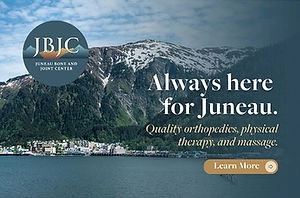A second Juneau-Douglas crossing is about community connections
- Guest contributor

- Aug 19
- 3 min read

By Irene Gallion
The recent closure of the Back Loop Bridge due to flood damage reminds us of something we all know deep down but don’t like to think about: bridges don’t live forever, and neither do our backup plans. It’s a timely nudge to revisit the idea of a north channel crossing — not as a luxury, but as a step toward resilience.
Imagine if Brotherhood Bridge were also out of commission. Folks isolated on the west side of the Mendenhall River might be heard saying, “Well, I will kind of miss Costco.” Meanwhile, those of us on the east side would be near hysteria — not because we’re cut off from the ferry terminal (our surface connection to the rest of the world), but because how are we supposed to make it through the weekend without a trip to Forbidden Peak Brewery or a round of disc golf at Aant’iyeik Park?
It’s a sobering reminder that it only takes a bit of enthusiastic water — just a brief surge — to cast doubt on the strength of our infrastructure. Which brings us to the Salmon Creek alternative for a north channel crossing. A recent study floated that idea, but one wonders: if we're worried about bridges in flood zones, should we really place all our hope in a 1914 dam that, if compromised, would do more than just cancel brunch plans?
Should the Douglas Bridge ever close, Douglas residents face two equally unpleasant options: either be stuck in Douglas without easy access to groceries and medical care, or be stuck in Juneau away from their homes, pets, and that comfy chair they’ve finally broken in just right. Emergency services on Douglas are limited to one station, and a trip to the hospital would suddenly involve a boat ride — which, while scenic, is not ideal when seconds count.
Still, the people of Douglas are nothing if not resourceful. I imagine that, within hours, there would be a full accounting of skiffs, kayaks and canoes, and someone would be drawing up a barge schedule. Naturally, priority would be given to restocking the pubs and eateries — because if we’re going to be stranded, we might as well do it with a pint in hand, surrounded by neighbors, happily griping over a hot plate of something comforting. It might even be fun — for a day or two.
But beyond just disaster scenarios, a north channel crossing could support thoughtful development on North Douglas, and perhaps bring more city services to the area. Yes, it might create what planners like to call a “development doughnut,” and what longtime North Douglas residents sometimes call “the beginning of the end.”
To those who moved out there for peace and quiet — to be far away but still close — I hear you. I grew up in a quiet spot that got developed, too. To this day, I reflexively resent paving. But then I see the new families moving in, planting flowers, riding bikes, building something — and, well, they seem to love it. They are healthy, happy, good neighbors.
In the end, a north channel crossing isn’t just about convenience or growth. It’s about connection — literal and figurative — and about giving this one-road town a second chance when the waters rise and infrastructure gives way. It’s worth a serious look. Preferably before the next bridge gets sentimental and decides it’s time to retire.
• Irene Gallion is an employee of the City and Borough of Juneau. The ideas and opinions expressed are her own, and do not reflect City and Borough of Juneau policy.












